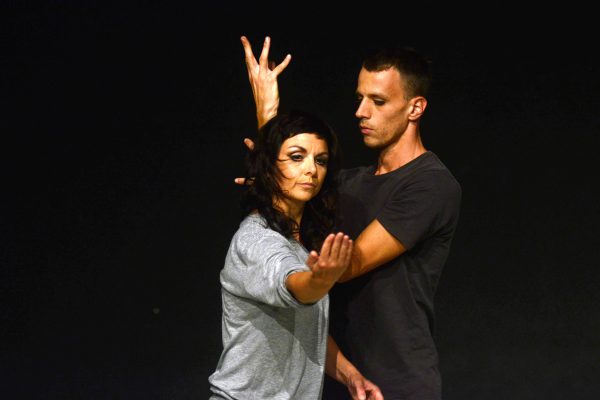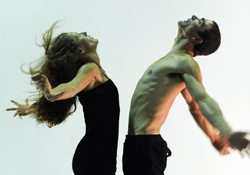Transformations: Expressions of Gender Roles in Asian Dance, presented by CanAsian Dance (June 8-11th, 2006), was like opening a jewellery box of precious gems or discovering buried treasure. The line-up of outstanding practitioners of Asian performing arts forms — dancers, choreographers and musicians — offered a rich and frequently breath-taking tapestry of movement, invention and artistry.
For this sixth instalment of the biennial festival, Artistic Director Denise Fujiwara appointed Toronto-based choreographer and composer Peter Chin as curator-in-residence. The result was an extraordinary mixed program that drew on the centuries-old tradition of cross gender performance in Asian culture. Legendary artists from Indonesia, Japan and China joined Toronto choreographers and musicians for performances, workshops and a lecture-demonstration, offering contemporary perspectives on these traditional and often overlooked forms.
The heady evening program opened with Master Song Chang Rong and Yao Zhong Wen from China performing an excerpt of “The Visiting Dragon Flirts with the Phoenix”, from the Peking opera repertoire. Regarded internationally as one of the finest performers of the Xun style of Peking opera, Master Song is one of the few remaining performers of his generation of nandan, male actors who play female roles. A student of one of the greatest Peking opera artists of the twentieth century, Master Song has performed across Asia and has made several trips to Toronto at the request of one of his own students, William Lau of the Little Pear Garden Collective. Master Song and Mr. Yao, taking on the hua dan (courtesan) and lao sheng (elderly man) roles respectively, gave brilliantly nuanced performances. Surreally poised on the threshold between past and present, the piece combined singing, dancing, acting and pantomime to tell the story of a beautiful and cunning maid (Song) and her attempts to outwit a common traveller who is really the emperor in disguise (Yao). At age seventy-one, Master Song was eerily convincing as he minced, demurred and schemed to win the approval of her haughty yet randy suitor.
Second on the programme was Elly, a young and astonishingly gifted dancer in the topeng or masked-dance tradition of Cirebon, a city on the north coast of Java. The only female on the program to play a male role, Elly performed “Klana Topeng,” a masked dance that tells the story of a dashing and courageous king who falls in love with a young princess. Moving like a stern, clockwork bird, Elly executed successive articulations of her head, neck, hyper-extended elbows, fingers and arched feet in sympathetic counterpoint. Her performance was nothing less than mesmerizing. Making her North American debut, Elly is the heir of venerated topeng master Rasinah, who was rescued from obscurity when the dance form garnered renewed interest in the 1990s.
Following Elly was the world premiere of Japan’s Yukio Waguri’s “Engagement”. Specifically commissioned for the festival, the piece depicted three scenes or shades of womanhood. Waguri, with whom Fujiwara has trained and worked, is a practitioner of butoh, a post-World War II Japanese dance form influenced by surrealism. Waguri was trained by one of butoh’s originators Tatsumi Hijikata and is regarded today as one of the form’s most important interpreters. In the first scene, Waguri appears in an oversized kimono, jet-black fringed wig and sightless noh mask, listing across the stage like a broken doll. In the second section, Waguri has shed the enveloping kimono and appears maskless in a red velvet evening gown and the characteristic white make-up of butoh. Reminiscent of Blanche Dubois’ painful “unmasking” by Stanley Kowalski in A Streetcar Named Desire, Waguri is agonizingly vulnerable as she implores the audience to see her and to love her. In the final phase, Waguri is dressed in a flesh-toned negligee dancing to a Japanese version of Bob Marley’s No Woman No Cry. Perching on a chair she is a Cabaret-style showgirl past her prime. Finally in the epilogue, Waguri strips to a tiny pair of black briefs. Wigless and bare-chested, he reveals where his white make-up – and his impersonation – begins and ends. He is a grotesque parody, all sinewy minimalism. Walking towards the audience, Waguri is harshly lit from the foot of the stage. His giant shadow has all the raw emaciated beauty of an Egon Schiele painting.
Rounding out the dense but highly entertaining first act was Toronto-based bharatanatyam dancer and choreographer Hari Krishnan’s new work “Uma”. Choreographed for the sleek Sudarshan Belsare, a bharatanatyam dancer based in Boston, the piece explores the eroticism and sensuality of the devadasi or temple dancers of the pre-modern south Indian state through the medium of stri-vesham, or female impersonation. Dressed in a fan-pleated dhoti and fitted choli blouse over pert falsies with a fake bun, long plait, jewelled headdress and nose stud, Belsare is by far the most convincing woman in the show. Yet what struck me as odd with Belsare and others was how the addition of fake breasts seemed to deprive the male dancers of any weight in their pelvises and legs, as though portraying femininity had something to do with defying gravity.
Impeccably lit by Arun Srinivasan, Belsare, Krishnan and six musicians process onto the stage as though taking part in a vigil. Evenly spaced, they walk in time to the ringing pulse of a woodblock answered by the soft tinkling of Belsare’s ankle bells. At downstage centre, Belsare pauses to glance coyly at her audience around the edge of her sari. With the musicians now arrayed around three sides of the stage, Krishnan waits for their attention and counts them in. Krishnan’s presence throughout the piece — as conductor, co-conspirator, and straight man to Belsare’s coquetry — creates a sense of intimacy, a feeling that one has happened upon a clandestine ceremony, something slightly wicked and forbidden.
Belsare is a consummate dancer, quick-footed and exact, with clean lines and rhythmic alacrity. Krishnan’s “chamber ensemble” comprised of two vocalists, percussion, violin and drone, performed a beautiful and varied score for the piece. Toronto-based interdisciplinary artist Katherine Duncanson rounded out the cast by providing spoken text in English to decode Belsare’s sections of abhinaya or story telling. Duncanson’s text was not the purple prose of translated Sanskrit poetry but the straight-talking, streetwise vernacular of a woman scorned. “You bitch,” Duncanson intones, “Get away from my man.” Here Krishnan is playing with the standard practice of providing non-Indian audiences with the Cole’s Notes version of the narrative. Though it added another layer of commentary on the work, Belsare’s gifts as an actress did not require subtitles.
The final work of the evening was perhaps the most ambitious but ultimately (and unfortunately) the most disappointing. Peter Chin, collaborating with Gamelan Toronto, invited renowned Indonesian performance artist Didik Nini Thowok to perform a classical Javanese dance as part of Chin’s new work “Berdandan”. Berdandan is Indonesian for “grooming”, “personal embellishment” or “dressing up”. Even before the audience had filed back into the theatre at the end of the intermission, the slight and serene Thowok began the meticulous process of transforming himself into a female dancer. Sitting at a vanity table downstage left and attended by his dresser (performer Yves Candau), Thowok applies his make-up, hairpieces, jewellery, foundation garments and outer costume in full view of the audience. As the transformation takes place, Thowok tells the fascinating story of how, with the encouragement of his grandmother, he became one of the few contemporary Indonesian artists to embrace the tradition of cross gender performance. As Thowok is speaking in Javanese, we learn his story through his dresser. Sitting on the floor beside his master, Candau becomes the child Thowok, sitting at his grandmother’s feet, simultaneously translating and recalling “his own story” to the audience in English. This interplay has a magical, timeless quality. The performance then turns into a kind of live documentary when photographer Cylla Von Tiedemann enters the stage and begins filming Thowok as he dresses. Her video close-ups are projected onto a draped fabric positioned upstage of Thowok. It is an interesting idea, but the poor quality of the projections coupled with Von Tiedemann’s intense presence disturbed the meditative atmosphere created by Thowok’s and Candau’s intimacy.
Through the telling of Thowok’s life story we learn that once upon a time a prince was invited to perform the Golek Lambang Sari dance, a cross gender work from the classical Javanese repertoire. The prince’s performance is so convincing that all the men in the audience are bewitched and fall in love with him. Here the play within a play motif comes to life when Thowok, finally dressed (a twenty-five minute undertaking), begins to dance. The set elements have been removed in slow motion by stagehands to reveal a full gamelan orchestra in ready attendance. Thowok is an exquisite and mellifluous dancer, and Gamelan Toronto is a worthy accompaniment; nevertheless, they are ultimately upstaged by the staging. Chin’s elegant concept is defeated by the presence of Von Tiedemann, the disorderly set, the too obvious stagehands and the fidgeting musicians in the background. In a final bizarre twist, while Thowok dances, Candau sits at his master’s dressing table and stares at himself in the mirror. The sequence makes for a clumsy attempt at questioning who is performing whom? Who has transformed whom? At this point, Thowok and Gamelan Toronto deserved the audience’s undivided attention.
In addition to the evening program, CanAsian also presented a ninety-minute lecture demonstration entitled “Cross Gender Traditions East and West Performance” on Saturday afternoon. The baroque ensemble, Toronto Continuo Collective, presented an excerpt from the 1654 comedic opera “Dal Male il Bene”. Responding to the theme of gender crossings through the tradition of the male soprano or castrati, Toronto-based theatre director Guillaume Bernardi invited alto Daniel Cabena to perform the female roles of Fortuna and Elvira in the opera. Though a bit reticent at times, Cabena and the musicians of the collective gave exemplary performances.
Neatly paired with the western operatic example was William Lau and Minh Ta’s performance of “The Lonely Widow” from the Peking opera. Embodying the qing-i or upright woman style, Lau appeared very much at ease as he sashayed across the stage in a pair of tiny heelless shoes fashioned to resemble the traditional bound feet of the nineteenth and early twentieth century.
The two pieces were followed by a panel discussion with Chin, Krishnan, Lau, Thowok, Bernardi, Cabena, Lucas Harris of the Toronto Continuo Collective and two distinguished professors of Asian literature. With little time to delve deeply into the many themes that resonated through the festival, the panellists discussed the urgent need to preserve and advocate for the disappearing art of cross-gender performance. They also suggested that while we advocate tolerance, the West still privileges hyper constructions of masculinity and femininity. In the end, the ever soft-spoken Thowok shared his beliefs that the harmonizing aspects of male and female essence could be a means of dispelling both the binary and the stigma of cross gender performance.
Tagged: Asian, Festival, Performance, ON , Toronto





